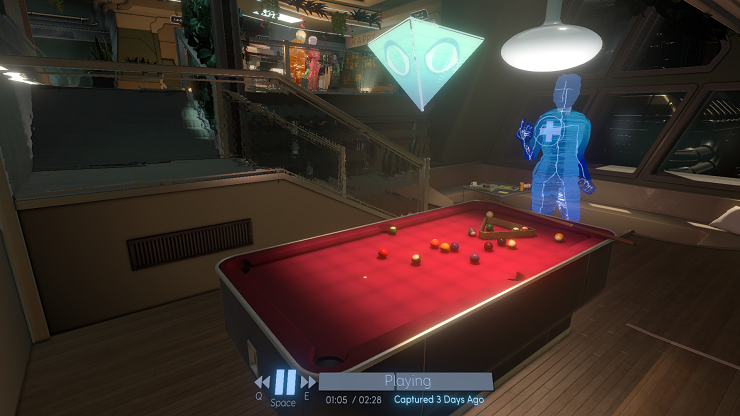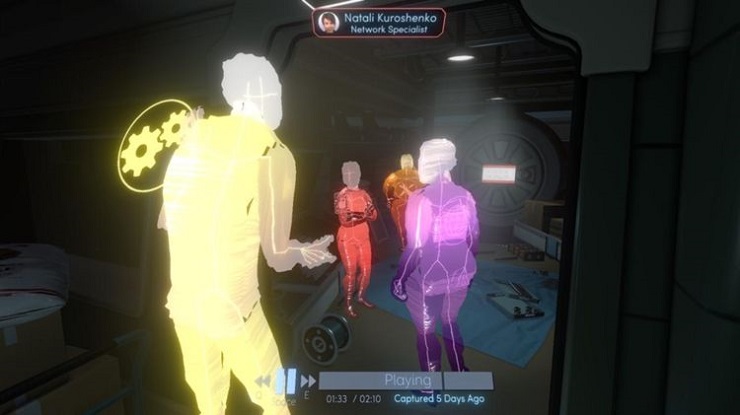Tacoma Review
August 2, 2017.
When I think about the time I had in Tacoma, I smile. I think about the jokes they made and the relationships they had, the struggles they faced, and the ways in which they grew from them, and tried to overcome them together. I think about EV’s broken guitar string, Clive’s Ian Fleming collection, and Andrew’s love of meditation. I think about the conversations, letters home, and everything else that painted pictures of a crew faced with the ultimate challenge of fighting for life over death. I thoroughly enjoyed what Fullbright has done with Tacoma, and I’ll never forget it.
You play the role of Ami Ferrier, an employee of Venturis Technology who’s been sent to recover the AI data from the space station Tacoma. On first arrival, things aren’t clear as to what has happened here, but the more you explore, read, and uncover, the dark tale of the crew’s fate becomes much clearer. Like Gone Home, there’s plenty of material to read. Sometimes you’ll pick up a letter one of the crew has written, or find a an electronic note on one of their workstations. There’re plenty of items around too, most of them are there to give the characters more personal definition which is fine because the journey is just as important as the destination here – look at everything, read everything, and see everything that there is to see.

To give context to the events you’re sent to investigate, there are points in which you can re-watch moments from the crew’s conversations and interactions. You find out early on that something has ruptured the hull of the station, and watching just how certain characters speak to each other reveals a hell of a lot. You find out whom is close to whom, the brevity of the situation the more you uncover, and what these people are really like. These memories can be rewound, sped up, and paused; this helps dramatically because they take place over a few rooms, so you can watch part of one memory, rewind then go to another part. Also, at certain parts of these AR data sections, you can read some of the crew’s AR Desktops.
AR Desktops act as a hub for emails, WhatsApp-like conversations, stored photos, and other digital information. By reading these you’ll find plenty of background to the story. You don’t have to read everything, but it makes a great deal of difference providing context to the story. You also have one yourself, which on occasion you’ll receive directions from Venturis about your next mission, a Crew Roster, and your identification. There are three separate areas of the space station: Personnel, Biomedical, and Engineering. In each area, you have to attach your hard drive to subtract the AI Data from it, but this takes a bit of time, going from 0 – 100%. Doing this allows you to take your time exploring the different sections, making sure you don’t rush around.
There’re seldom puzzles in Tacoma that mainly revolve around finding a passcode to get into someone’s personal quarters, or other locked doors. They’re not too taxing, but they are layered, so they help to add more exploration to each area. For example, in the Personal Quarters you have to find a passcode for a locker, where you’ll find a physical key to open up a drawer, eventually finding some useful information there to flesh out one of the character’s backstories.

It’s not just the story I found engaging about Tacoma. The environments themselves are well-designed, full of interesting rooms and non-essential places like toilets and washrooms. The station feels lived in and real, and it acts as a home for these people you end up feeling a great affinity with. It also feels vast, especially when you look through one of the windows, gazing upon the emptiness of space and planet Earth that lies in the distance. There’s a minimal amount of music in the game as well, and it’s noticeable. It makes the isolation of being in space feel all the more real.
I prefer the story of Tacoma to Gone Home because of the way it shows off the closeness of the crew, and their response to potential tragedy. The emails to Earth, the worrying internal messages to each other, and how their love and respect for one and other becomes more apparent as the game reaches its climax. There’re moments I felt heartbreak for some of them, but there were also moments I laughed at how sweet and silly they were, and how love and kindness can give people strength in the most dire of circumstances. Although the ending was a bit flat and a bit anticlimactic, I adored Tacoma. If you’re a fan of Gone Home, or science fiction for that matter, the journey you’re about to embark on in Tacoma will make you appreciate the ones you love and hold dear, and show you just how amazing storytelling in video games can be.
Fantastic story
Well-designed environments
Characters are interesting
AR Data segments are excellent
Ending isn't as strong as the story
If you're a big believer in great storytelling in video games, Fullbright has once again nailed it, proving it can be done, and it can be done to the highest standard.





